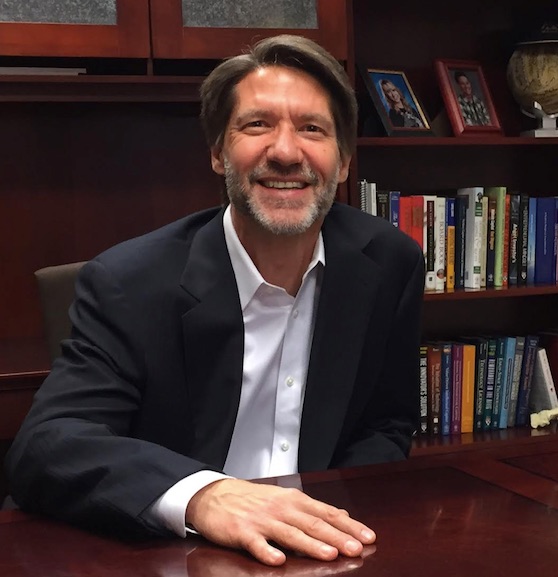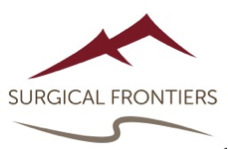
This is the 2nd in the interview series of 6-Question interviews with the leaders who are challenging conventional thinking in Orthopedics. (you can read other interviews here)
I met Wade Fallin in 1987 at Richards Medical (now Smith and Nephew) when he was bright young product development engineer. Since that time, Wade has gone on to start multiple companies and has driven tremendous valuations with innovations in Orthopedics – Hayes Medical, Medicine Lodge, Innovasive Devices, IMDS, Facet Solutions, VentureMD, and now Surgical Frontiers.
Wade is unique in his ability to seamlessly move across all treatment areas in Orthopedics, including Sports Medicine, Trauma, Joints, and Spine. His roles have also been very versatile. Wade’s career has spanned from technology development, IP development, funding, executive management, to M&A. He always seems to be ahead of the curve with technologies and treatments in Orthopedics.
I sat down with Wade and asked him a few questions about his most recent venture – Surgical Frontiers.
1. How did Surgical Frontiers come about?
Wade Fallin: Some of the members of our team met early in our careers in the 1980’s at the large orthopedic companies, and the rest of us came together for the first time to start the second MedicineLodge in 2000 or to start Facet Solutions in 2002. That means we all benefit from 10+ to 20+ year relationships, providing exceptional trust and confidence in each other, not to mention learning together what does and doesn’t work in a start-up!
So, as a group of serial orthopaedic start-up experts, we came together to form a company that is a generator and operator of serial start-ups. Now we have an organization with a lifespan that is a multiple of start-up company lifespans: identify the opportunity –> create the startup –> fund –> operate –> and exit. Our families are much happier now that we have a more lasting job than we did as serial entrepreneurs!
2. What is the focus of Surgical Frontiers?
Wade Fallin: The short answer is we collaborate with leading surgeons to improve patient outcomes. Together we solve clinical problems or improve clinical outcomes, and our principles of collaboration are putting patient outcomes above all else, integrity and mutual trust and respect.
We focus primarily on musculoskeletal problems, and we focus on opportunities that improve health care value by increasing the reliability and efficacy of surgical procedures. If you think of value as a benefit-to-cost-ratio, than we can improve surgical procedure value by improving outcomes or decreasing cost, or to really change the value proposition, improving both at the same time.
A recent example of this approach to innovation is one of our VentureMD portfolio companies, MTP Solutions. After surveying clinical outcomes for patients with hammertoe and lesser toe instabilities, we noted that up to 50 percent of the approximately 500,000 annual surgical patients were dissatisfied with their outcomes at 2 years – clearly a significant need for improvement!! As we researched the opportunity, particularly for lesser toe instabilities at the metatarsophalangeal joint (MTP joint), we noted that the two most popular standard-of-care techniques were a tendon transfer procedure and a bone shortening decompression procedure. The underlying pathology of torn or attenuated ligaments, the source of the instability, was not being addressed. So we believed that if we could enable the first, true anatomic repair of the five individual ligaments that stabilize the MTP joint, we could produce more predictable and better outcomes, and provide patients with significantly improved function and better pain reduction than the procedures currently in use.
Another key aspect of our focus is first to identify the right opportunity, then find a technology solution that best fits the opportunity. There are a number of start-ups with cool technology looking for problems to solve; certainly a riskier approach, in our estimation!
Going back to the example of MTP Solutions, we had the good fortune to partner with foot and ankle orthopaedic surgeons and podiatrists that were leaders of their respective professional societies. So when we launched the company, we didn’t have a solution, but we had a great foundation: a significant problem to solve, a fantastic team, and funding to get us to pilot clinical trials. The technology is something that we figured out along the way, and we used restoration of normal biomechanics and surgical procedure efficiency as our guiding principles to select and refine the inventions we created to solve the problem.
3. How does Surgical Frontiers business model work?
Wade Fallin: We run the whole start-up process: identify the opportunity –> create the startup –> fund –> operate –> and exit. We have raised our first fund that is providing the majority of the capital for our first three start-ups. We are certainly open to other funding mechanisms for future start-ups, but we anticipate raising sequential funds.
Our business model is built on the principles of capital efficiency and lean start-ups. We can deliver the same results as traditional start-ups with a lot less capital. The way this works is by leasing our employees at Surgical Frontiers and our incubator facilities in Logan, Utah, to our start-ups on an as-needed basis. For example, an early stage start-up has a high burn rate due to high fixed salary and overhead expenses. But in our model, a start-up can “lease” a part-time CEO or CFO or regulatory submissions expert or engineer as needed to achieve target milestones. Our costs are essentially equivalent to the fully burdened costs of an in-house employee, so the costs are typically 40% to 50% less than the costs for traditional outsourced services. Also, this model provides an “instant-on” infrastructure, avoiding the need to rebuild these systems as many start-ups do. Infrastructure includes facilities, quality system, financial reporting systems, inventory management systems, contract templates, and the like. This allows us to launch a new start-up within weeks of completing a fully vetted business plan.
4. What does the Surgical Frontiers organization look like?
Wade Fallin: Our company looks a lot like an orthopaedic start-up. We are staffed with expertise spanning all functional areas required by start-ups: executive management, finance, operations, quality, regulatory, legal, intellectual property, and research and development. Because start-ups are most heavily focused on R&D, most of our employees are in R&D, with access to on-site testing and prototyping facilities. The company is ISO 13485 certified and maintains compliance with FDA QSR’s, AdvaMed Code of Ethics, and, of course, other applicable legal and regulatory requirements.
5. Is there a consistent exit strategy for your start-up companies?
Wade Fallin: Generally speaking, our model is “Concept to Clinic.” We develop advanced surgical systems that are ready for clinical use. Our ideal exit point is the stage where the technology has regulatory clearance, has pilot clinical use, and is production ready, so that a commercial partner can step in and immediately begin building launch inventory and preparing for commercial launch. We really aren’t interested in building sales and marketing organizations; we prefer instead to partner with those that have an established global presence in the market.
Again, going back to the MTP Solutions example, we completed all of the development and regulatory work and built inventory to support pilot clinical trials of the new anatomic repair system for lesser MTP joint instabilities. Upon completing pilot clinical cases and seeing very promising early clinical results, we then looked for a commercial partner with a global presence. We are most pleased to have partnered with the outstanding extremities and trauma team at Smith and Nephew, where Tiger and I first met, to commercialize the system now known as the Hat-Trick Lesser Toe Repair System. And the most rewarding aspect of this exit is hearing the enthusiasm from the surgeons now using the system for how this technology has provided better and more predictable outcomes for their patients.
6. How does Surgical Frontiers innovate simultaneously in Foot & Ankle, Sports Medicine and Trauma?
Wade Fallin: Most of our team has had a long-term career focus in all aspects of the musculoskeletal market, giving us great insights into surgical and clinical principles that correlate to effective clinical outcomes. We combine these insights with one of our greatest strengths, invention and intellectual property development. This includes developing patent portfolio with strong protection, ensuring freedom to operate, and inventing new technology solutions that address those promising opportunities previously identified. Over the course of our careers, our team members have been co-inventors on over 350 issued U.S. patents to date.
Below are a few ways to reach Wade Fallin at Surgical Frontiers:
800-230-3710
124 South 600 West, Suite 100
Logan, UT 84321
Enjoyed this article?
If you know of other people who are challenging conventional thinking in Orthopedics, drop us a note and we will interview them: 6Qsuggestion @ orthostreams.com

 Tiger Buford – retained recruiter dissecting orthopedics
Tiger Buford – retained recruiter dissecting orthopedics 